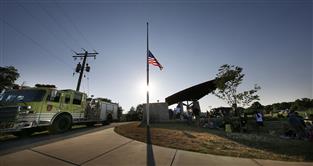Eschweiler plans edge toward partial preservation
The latest concept to preserve the historic Eschweiler structures calls for renovating the administration building, using the ruins of two buildings to create walled gardens and eliminating the fourth building entirely.
Mandel Group has yet to file a formal proposal to redevelop the buildings as part of the Innovation Park campus. Still, the developer made a conceptual pitch to the city's Historic Preservation Commission on Aug. 1, reiterating that it is highly unlikely all four of the buildings could be preserved, given the costs.
"It was initially unthinkable to take down (any buildings), but after research no financial package would make it feasible to save all of them," said Phil Aiello, senior development manager with Mandel Group.
Reviewing cost factors
To redevelop the Eschweiler buildings into 41 apartment units would come at a per-unit cost of about $365,000 verses $200,000 for new construction, Aiello said, adding that the units would also command less rent because of a lack of modern amenities.
"Part of the issue of the high costs is the state of disrepair these buildings are in," Aiello said.
The buildings are plagued with roof decay, deteriorating bricks and damage from Mother Nature and vandals, he said.
The city has hired consulting firm Springsted to verify construction costs and determine if Mandel Group's calculations are correct.
Springsted worked with the city in 2010 to crunch numbers before Wauwatosa agreed to provide $12 million in assistance for infrastructure to the Innovation Park project as a whole in the form of a tax-incremental financing district.
Renovation in concept
Mandel Group plans to ask the city to establish a $2.5 million tax-incremental financing district that would allow the developer to renovate the administration building.
As conceived, the main floor of the administration building would offer amenities - such as a fitness room and theater - for people living on site.
However, the majority of the three-story building would offer office and meeting space for nonprofit groups - a tribute to the history of the buildings, former agriculture school and County Grounds - and provide workspace for an artist in residence, company Chairman Barry Mandel said.
The public would also benefit from English-style walled gardens using shells of the partly demolished former dairy and dormitory buildings, architect Jim Shields said.
Nearly 200 new apartments would be constructed in buildings that create a crescent around the campus green and administration building. The latest plan also calls for installing an outdoor swimming pool as an amenity for the renters.
Bob Dennik, a past economic developmen director for Milwaukee County, said he was impressed by plans.
"This is the most innovation plan I've seen so far," he said, explaining that he had showed the property to dozens of developers over the years and none would take it on.
Public concerns about plan
But some residents attending the Aug. 1 meeting questioned whether money going toward a swimming pool and turning ruins into gardens couldn't better be spent to save entire buildings.
And Frank Butterfield with the Wisconsin Field Office of the National Trust for Historic Preservation, also noted that when the redevelopment project was initially pitched to the city, the assumption was that the historic buildings could be preserved, paid for by new development in Innovation Park. That was the reason for public support of the project.
However, now that doesn't seem to be the case, Butterfield said, given that most of the buildings wouldn't be saved and funding in the form of a tax-increment financing would be requested to rehabilitate the administration building.
A number of environmental preservationists voiced concerns about how the changes to the district could impact the neighboring butterfly habitat.
"The historic areas and the habitat benefit each other," said Barb Agnew, president of the Friends of the Monarch Trail. "Changing shape of building and placement changes the habitat system."
Chairman Brian Faltinson said the commission had no say over environmental issues and would only be looking at the historic preservation aspects of the project.
If Mandel Group does submit a formal plan, the commission would be the first group to discuss it, deciding whether it was an appropriate use of the historic district.
"Every meeting, the plan has evolved and become more thoughtful incorporating ideas from a variety of people," Faltinson said.
More from News and Features
- Anodyne Coffee plans to open location in Wauwatosa Village
- Wauwatosa Meetings: Aug. 4
- Video: Wauwatosa girl's curbside ice cream stand raises money for the hungry
- Wauwatosa News and Notes: Hands-only CPR training offered; Firefly Art Fair is Aug. 6-7
- Wauwatosa Ask Now: Why are there barriers and fencing along the North Avenue bridges over the Menomonee River?
- Mystery Photo Contest: July 28
- Wauwatosa gears up for National Night Out event, this year at the zoo
- Election 2016: Wisconsin's 4th District candidates weigh in
- Wauwatosa's Luther Manor residents share smiles through flower delivery
- Wauwatosa Police Report: July 17-23















